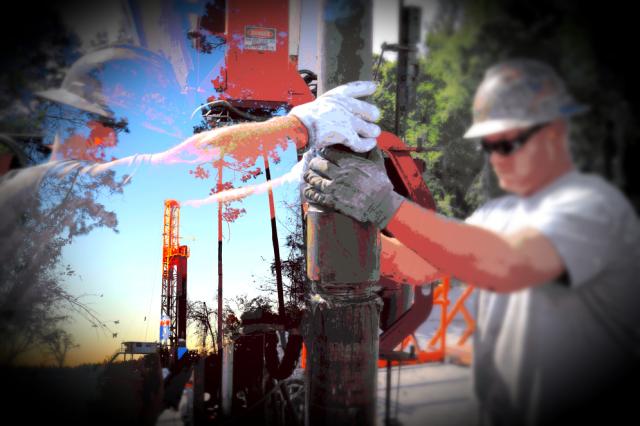
Shares of EQT, the largest U.S. gas producer, were up 20% in the month to April 1. Shares of Cabot Oil & Gas and Southwestern Energy were also up. (Source: Hart Energy)
While rock-bottom oil prices wreak havoc across the U.S. energy sector, there are some drillers for whom the historic bust has proven a share price boon: specialists in natural gas.
Some gas futures prices are up almost 10% since the end of February over the same period that U.S. crude oil has more than halved.
The reason: billions of dollars of capital spending cuts announced by U.S. shale oil companies are likely to lead to lower output of so-called associated gas, natural gas produced as a byproduct of wells drilled mainly for their oil.
By some forecasts, total U.S. gas production could be down more than 10% by the end of next year, with significant consequences for companies involved in transporting and exporting the commodity.
The prospect of higher prices has provided a modest boost to exploration and production companies that drill mainly for gas.
Shares of EQT Corp., the largest U.S. gas producer, were up 20% in the month to April 1. Cabot Oil & Gas Corp. was up 14% and Southwestern Energy Co. was up 12%. A broader S&P index of exploration and production companies was down 49% over the same period.
The U.S. is the world’s largest natural gas supplier. Production is now about 92 Bcf/d, half of which is associated gas, according to S&P Global Platts. Oil-rich regions such as the Permian Basin of Texas and New Mexico produce large volumes of associated gas.
If oil producers slashed spending aggressively, total U.S. gas production could decline to as little as 82 Bcf/d by the end of 2021, said Francisco Blanch, head of commodities research at Bank of America. “That is a big chunk of gas disappearing from the system,” he said.
Associated gas output could slip by 1.5 Bcf/d by the end of 2020 and another 2 Bcf/d in 2021 if oil prices remain low, said Anne Robba, head of Americas gas and power analytics at S&P Global Platts.
Spot prices for oil and gas are both very low, with front-month WTI crude settling at $20.31 a barrel on April 1 and benchmark Henry Hub natural gas falling to $1.587 per million Btu, the lowest price since 1995.
Yet, May 2021 gas futures ended 0.8% higher at $2.348, continuing their modest rise over the course of the past month. The average full-year price of U.S. gas futures for delivery in 2021 has risen 9.4% since the end of February.
While the economic damage from coronavirus is likely to hit commercial and industrial demand for natural gas, demand for the fuel for heat and electricity generation is relatively steady. In the deep recession of 2008-09, US gas consumption fell 2%.
The pain caused to oil drillers by the collapse in crude prices will be familiar to investors in natural gas companies, which have struggled with low prices for much longer. Despite the modest uptick recently, EQT suspended its dividend last week to free up money for paying down debt.
The likelihood of less activity in the Permian Basin has wide consequences not just for drillers but also for companies involved in building infrastructure to move the gas produced there and for those hoping to export it.
NAmerico Energy Holdings LLC has put on hold its proposed Pecos Trail pipeline that would have brought West Texas gas to the Gulf of Mexico, said Jeff Welch, president of the private-equity-backed logistics company.
“We’re just being responsive to what’s going on, recognizing that the upstream sector is not going to see the growth that people had expected,” Welch said.
Higher U.S. gas prices could further cloud the outlook for companies seeking buyers for LNG from proposed terminals along the East and West Coasts, given U.S. output is no longer a bargain relative to gas elsewhere.
The Japan-Korea Marker gas price assessed by Platts fell to a fresh low of $2.622 per million Btu this week, barely a dollar above the U.S. spot price.
This week Royal Dutch Shell Plc exited the proposed Lake Charles LNG export project in Louisiana, set up as a joint venture with Energy Transfer LP, citing “current market conditions.”
Recommended Reading
Defeating the ‘Four Horsemen’ of Flow Assurance
2024-04-18 - Service companies combine processes and techniques to mitigate the impact of paraffin, asphaltenes, hydrates and scale on production—and keep the cash flowing.
Tech Trends: AI Increasing Data Center Demand for Energy
2024-04-16 - In this month’s Tech Trends, new technologies equipped with artificial intelligence take the forefront, as they assist with safety and seismic fault detection. Also, independent contractor Stena Drilling begins upgrades for their Evolution drillship.
AVEVA: Immersive Tech, Augmented Reality and What’s New in the Cloud
2024-04-15 - Rob McGreevy, AVEVA’s chief product officer, talks about technology advancements that give employees on the job training without any of the risks.
Lift-off: How AI is Boosting Field and Employee Productivity
2024-04-12 - From data extraction to well optimization, the oil and gas industry embraces AI.
AI Poised to Break Out of its Oilfield Niche
2024-04-11 - At the AI in Oil & Gas Conference in Houston, experts talked up the benefits artificial intelligence can provide to the downstream, midstream and upstream sectors, while assuring the audience humans will still run the show.





